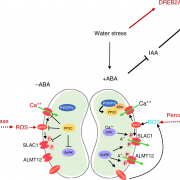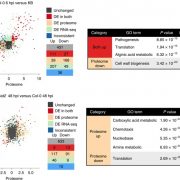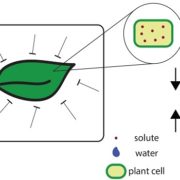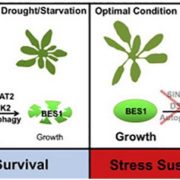How Plants Keep Troublemakers Out and Water In
Kaundal et al. examine how a protein keeps plants safe from invading pathogens and dehydration http://www.plantcell.org/content/29/9/2233
By Amita Kaundal, Vemanna S. Ramu, Kirankumar S. Mysore
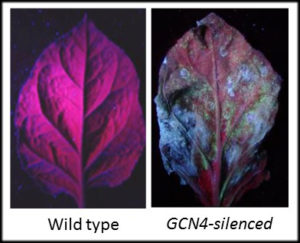
Five days after exposure to the bacterial pathogen Pseudomonas syringae pv. tomato T1, leaves of normal (wild type) plants remain uninfected, whereas leaves of GCN4-silenced plants show disease symptoms. This shows that GCN4, which is present in the wild type, plays a role in preventing disease. Plants were photographed under UV light to visualize symptoms.
Background: To cause disease in plants, bacteria must enter plant tissue and multiply. Bacteria and some fungi enter plant tissues through the stomatal pores that mediate gas exchange and water transpiration. Plants can sense the presence of pathogens on their leaves and close their stomata. However, some species of pathogenic bacteria and fungi produce toxins that reopen stomata, allowing the pathogen to enter the plant tissue.
Question: We wondered how plants close their stomata when threatened by invading pathogens or unfavorable environmental conditions such as drought.
Findings: We identified the protein General Control Non-repressible-4 (GCN4) as a new player in the opening and closing of stomata during biotic and abiotic stress. When the GCN4 gene was silenced in Nicotiana benthamiana (a relative of tobacco), the bacterial pathogen Pseudomonas syringae pv. tomato T1, which normally does not infect this plant, caused disease symptoms. When we overexpressed GCN4 in the model plant Arabidopsis thaliana and dipped those plants in solution containing the pathogen, the plants did not get infected. However, these same plants succumbed to infection when the pathogen was forced into leaves using a syringe. As expected, normal A. thaliana plants were infected by both types of inoculations, as were plants in which the GCN4 gene was silenced. These findings prompted us to investigate stomata in plants overexpressing GNC4. Intriguingly, when exposed to pathogens or pathogenic toxins, plants overexpressing GCN4 did not re-open their stomata, whereas plants with reduced levels of GCN4 protein never closed their stomata. Thus, this protein enables plants to shut their stomata in times of stress. As stomata also conserve water in plants, it was not surprising that plants overexpressing GCN4 were more tolerant to drought stress than normal plants. To further explore the role of GCN4 in stomata, we examined how this protein interacts with other proteins previously shown to regulate stomata. We found that GCN4 regulates stomatal aperture by degrading specific types of proton pumping proteins.
Next steps: Our discovery of a previously unknown function of GCN4 in regulating stomatal aperture size provides insights that can be used in crop improvement programs aiming to develop pathogen-resistant and drought-tolerant crops.
Kaundal, A., Ramu, V.S., Oh, S., Lee, S., Pant, B., Lee, H.-K., Rojas,C.M., Senthil-Kumar, M., and Mysore, K.S. (2017). GENERAL CONTROL NONREPRESSIBLE4 Degrades 14-3-3 and the RIN4 Complex to Regulate Stomatal Aperture with Implications on Nonhost Disease Resistance and Drought Tolerance. Plant Cell 29: 2233-2248; DOI: 10.1105/tpc.17.00070.



